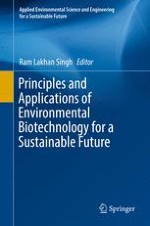2017 | OriginalPaper | Chapter
4. Bioremediation of Plant Refuges and Xenobiotics
Authors : Soni Tiwari, Ashutosh Tripathi, Rajeeva Gaur
Published in: Principles and Applications of Environmental Biotechnology for a Sustainable Future
Publisher: Springer Singapore
Activate our intelligent search to find suitable subject content or patents.
Select sections of text to find matching patents with Artificial Intelligence. powered by
Select sections of text to find additional relevant content using AI-assisted search. powered by
